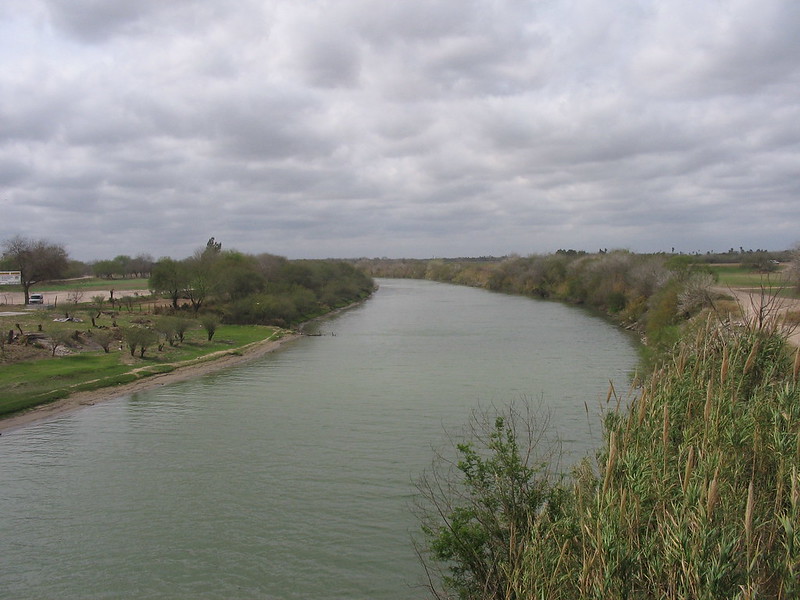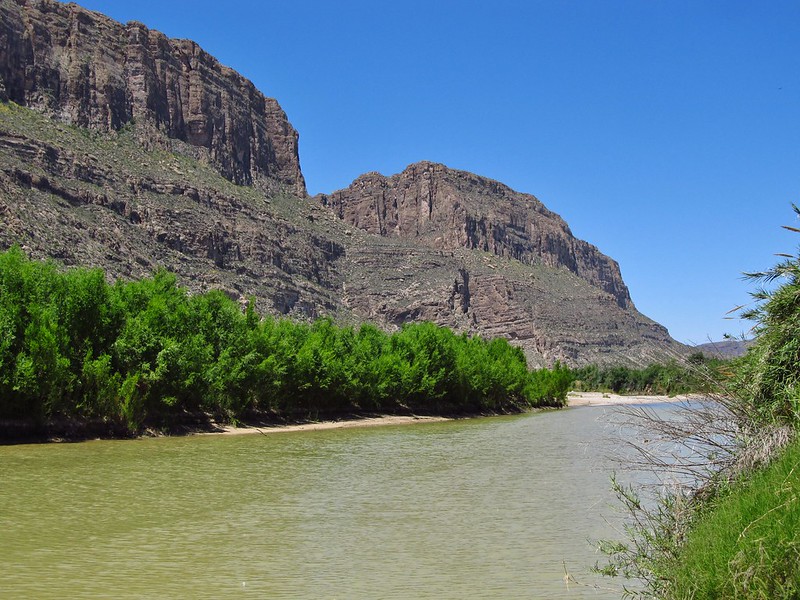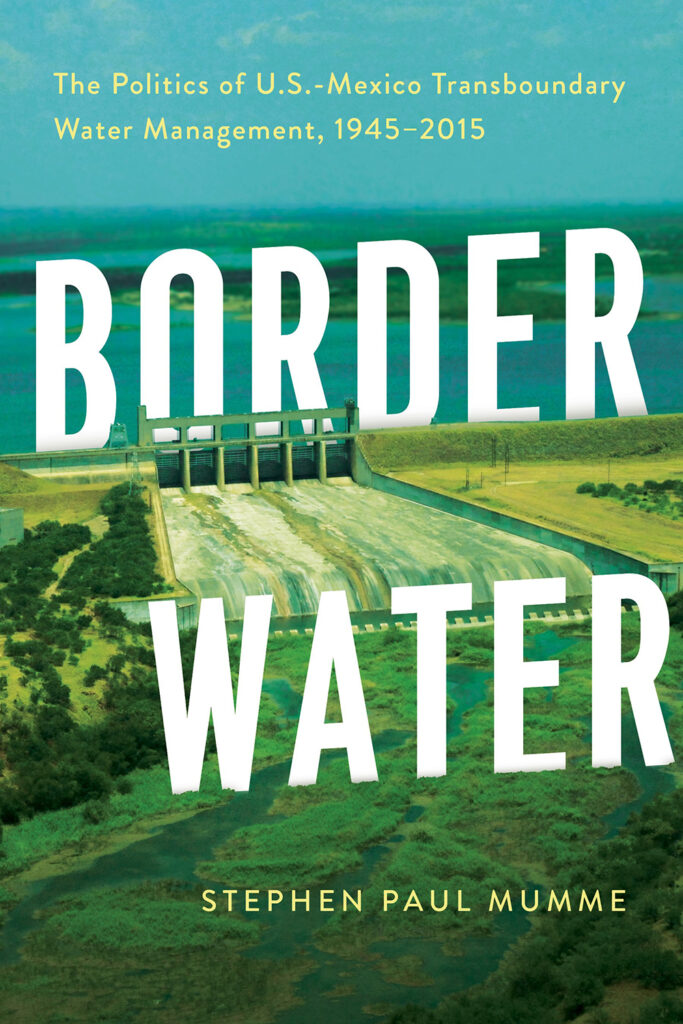
The Texas Department of Public Safety last month deployed floating barriers, featuring large buoys and razor wire, in the Rio Grande along the border. The controversial Operation Lone Star program is part of Gov. Greg Abbott’s $4 billion attempt to deter migrants from attempting to cross the dangerous river.
In addition to an official complaint filed by Mexico, the U.S Department of Justice is now suing the Lone Star State, noting that Texas doesn’t have the authority to implement boundaries in shared waterways, and almost 80% of the barrier is technically on the Mexican side of the U.S.-Mexico border.
Both the complaint and the lawsuit point to the 1944 Water Treaty, which regulates the distribution of water from the Colorado, Tijuana and Rio Grande rivers.
Colorado State University Political Science Professor Stephen Mumme researches water and environmental management along the U.S.-Mexico border. He’s also the author of the new book, “Border Water: The Politics of U.S.-Mexico Transboundary Water Management, 1945–2015.” SOURCE recently spoke with Mumme about the lawsuit and the water boundary treaty it’s based on.
How exactly does the 1944 Water Treaty, which largely focuses on how much water is delivered to Mexico, impact this case?

The 1944 Water Treaty is one of the most important treaties we have with Mexico because it determines the sovereignty over transboundary rivers. But it’s much more than that. It also enfolds all the boundary treaties under its umbrella. It created a binational agency called the International Boundary and Water Commission, which has the exclusive authority to make decisions about the administration of the rivers and the maintenance of the boundary.
But Texas Gov. Greg Abbott and his staff didn’t consult the IBWC when they went ahead and placed buoys in the river. They also didn’t consult the U.S. Army Corps of Engineers, which is responsible for assisting the IBWC in maintaining navigability of the river and its boundaries.
I’m always telling my students that one of the problems here is that, when we think about the boundary with Mexico, we tend to think of it as a straight line. But in fact, we have riparian boundaries that are always dynamic. They’re always moving. If water flows, boundaries move.
And the 1944 water treaty isn’t the only bilateral treaty being questioned in this case, correct?
Correct. Really the most important boundary treaty that we have with Mexico is the 1970 Boundary Treaty — signed by then-U.S. President Richard Nixon and then-Mexican President Gustavo Díaz Ordaz — because it represents the culmination of over 100 years of debate and discussion about how to manage the boundary, which was originally set by the 1848 Treaty of Guadalupe Hidalgo. The goal was to try and maintain the boundary as steadily as possible.
One of the things the 1970 treaty stated was that no country can build structures in or near the river without the approval of the other country. Because of the risks structures can pose to both countries, there must be mutual agreement between Mexico and the United States if either is going to do something that would potentially impact the boundary. There are actually many mutually agreed-upon levees along the lower reach of the Rio Grande to keep the water inbound and prevent flooding.
But the treaty is very clear on how this should be done. Even with the backing of the federal government, one country couldn’t do what the governor of Texas has done. Making this is a clear violation of the terms of the 1970 Boundary Treaty.
There are a lot of arguments being made specifically regarding the buoys and razor wire from safety and humanitarian standpoints. But what about from the water management standpoint? What kind of impact could these structures have on the river?
That’s the problem — we don’t know. This is why we have the process that we have. Because what should have happened is Gov. Abbott should have taken his plans to the U.S. section of the International Boundary and Water Commission, and they could then, either by using their own engineers or hiring an independent consulting firm of engineers, look at the plans, look at the dynamics of the river and then determine whether or not those plans would create a deflection, or a complication.
If they were convinced that it wouldn’t cause a problem, then they would go to Mexico and have their engineers look at it to see if they agree or disagree. It’s through that type of careful, back and forth process, using good technical standards, that you come to an agreement. That just wasn’t done here.

What kind of impact could this have on current and future U.S./Mexico relations?
Mexico’s foreign minister, Alicia Bárcena, and its ambassador, Esteban Moctezuma Barragán, have already both issued formal complaints. It has the potential to have serious implications because this issue involves a particularly important aspect of Mexico’s sovereignty — its sovereignty vis a vis the United States.
That’s a very historic and painful history as the U.S. absorbed nearly half of Mexico in 1848. So, Mexico doesn’t like to be viewed as subservient to U.S. policy. They want to be treated independently with respect and dignity, as they deserve to be. So, proceeding unilaterally like this and ignoring Mexico entirely is an insult, and an indignity. It violates the kind of relationship that the U.S. and Mexico want to have.
It also has the potential of blowing up into a big political issue. Mexico’s going into a presidential campaign next year, as is the U.S. Could this be politicized? Yes, because it looks like the U.S. is encroaching on Mexican sovereignty. If Canada were encroaching on U.S. sovereignty, you can be sure that some U.S. presidential candidate would make a campaign focus out of it. It could be a significant issue if the Biden administration doesn’t hasten to work this out. I’m sure that they’re trying to work with Mexico behind the scenes and now the Justice Department is suing the state of Texas, which is the logical next step.
Does Texas have an argument here? Is there any “wiggle room” that you can see where they might be able to make a case?
The state of Texas doesn’t have a leg to stand on. This is a pretty cut and dried case because there’s nothing that I’ve seen, either in U.S. domestic law or in treaty law, that allows for this kind of unilateral decision. Mexico also has the recourse of taking this to an international tribunal if it wants to.
The U.S. State Department has worked extremely hard and very successfully over the years to keep these things out of international courts and resolve them amicably. I think that’s something the U.S. can be proud of, and I think that’s what the Biden administration is going to try and do again here.
Your latest book, “Border Water” looks at the politics of U.S.-Mexico transboundary water management from 1945 to 2015. Have you seen other cases like this before?

Interestingly, there haven’t been many. This is a uniquely insulated area of U.S. and Mexico public policy in which there has been a high level of cooperation. There are real differences there. There are issues. There are frustrations involving the boundary and water rights, and the drought is complicating matters. But we’ve managed this relationship very successfully, something that both countries should be proud of.
Around 2007-08 when the Bush administration began building more barriers along the border, it did have the authority in U.S. domestic law to override a lot of state, local and federal laws to get this work done. That was a real opportunity to move forward with barrier building along the border. When they began to do it, there were a lot of angry reactions by Texas property owners who had their property condemned in order to build these barriers. The barrier project ended up using different types of structures in various places — steel bollard-style steel fences in some places, Normandy-style vehicle barriers in other places. And in some places, it was more controversial than in others.
What was the reaction from Mexico?
Mexico began to worry about where barriers were being built along the river as potential impediments, and it raised that issue with the United States, and the U.S. raised it with Homeland Security and the U.S. section of the IBWC.
There was a lot of discussion and, while I don’t know for sure, I’m guessing there was some modification of plans because at the end of the day, Mexico did not issue a formal protest. This was all worked out very quietly behind the scenes, although there were a lot of local landowners protesting and pointing fingers at the IBWC saying that they should be doing more to protect the U.S. But it was dealt with in this quiet, evenhanded way. A lot of that wall building did go forward, presumptively with the tacit forbearance of the International Boundary and Water Commission.
Then in 2018, 2019, a private group associated with Steve Bannon and some people here in Colorado created the nongovernmental organization: We Build the Wall. They decided that if the federal government wasn’t going to act fast enough to build these barriers, they were going to work with private property owners, raise the money, and build the wall themselves. They built some in El Paso that were ham handedly done and were criticized by the IBWC because it prevented them from monitoring the river in places.
Did it impact the river in other ways?
Further down along the river near Roma, Texas, they built bollard-style fences right on the edge of the river. That was a problem and Mexico protested. The U.S. section of the IBWC sued Fisher Sand & Gravel, which was the engineering firm contracted to build the walls. Fisher eventually agreed to cease and desist, and the suit was settled out of court, with Fisher agreeing to correct the errors and absorb all the costs for any damages incurred.
While that lawsuit was resolved out of court, it showed that the U.S. section of the IBWC was obviously paying attention and that it would use the courts to go after interests that were not proceeding in the proper way with barrier construction along the river. And during that case they did invoke the 1970 Boundary Treaty. The federal attorney down in Brownsville also saw the case as a slam dunk.
So, why then are we seeing a similar issue again?
I think the problem here is that we have a system for managing the boundary and managing our water. It works and it works well, but from time to time, things are going to get political. The issue here right now in Texas isn’t about the boundary or about water management. It’s about immigration. This is simply an attempt to unilaterally move ahead of U.S. immigration authorities to deal with a specific perceived problem.
Mexico is rightly concerned about the razor wire because while it’s hard to say how much of an impediment that would be to the river — although it is a barrier that needs to be studied and authorized — nevertheless, it’s also inhumane. It means a lot of desperate people who are trying to reach the United States to claim asylum, to claim the opportunity for a better life, are simply going to get lacerated. Men, women and children.
There must be better deterrents. I really want to stress that we need Mexico as a partner to deal with these kinds of issues and by far it has been willing to lend a hand. We must find more cooperative ways of handling a lot of these issues that arise along the international boundary because when we do, everything works better.